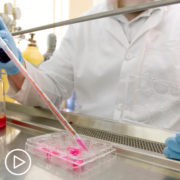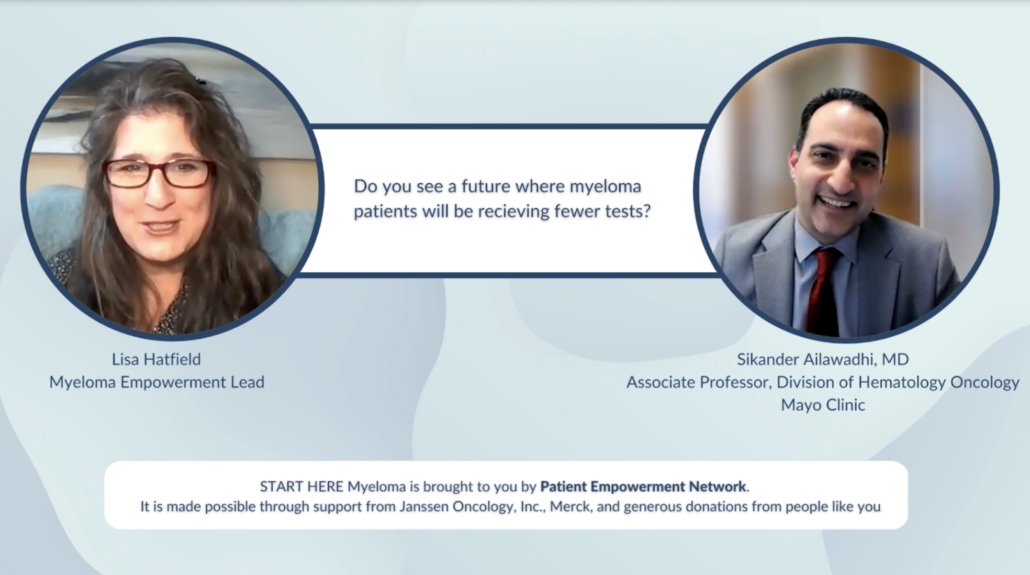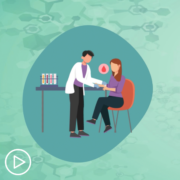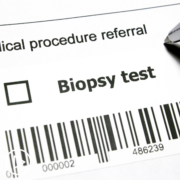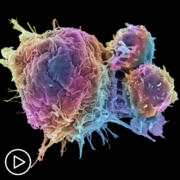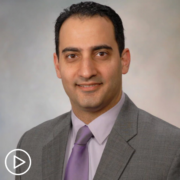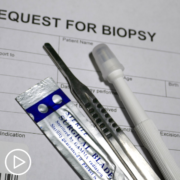What Should You Know About Emerging Myeloma Treatment Options? from Patient Empowerment Network on Vimeo.
With myeloma treatment and research advancing quickly, it’s important to stay up-to-date on the latest therapies. Myeloma expert Dr. Jeffrey Matous reviews new and emerging myeloma treatment approaches, how these therapies work, as well as the potential risks and benefits of each option. Dr. Matous also shares resources for learning about myeloma and how to access better care.
Dr. Jeffrey Matous is a myeloma specialist at the Colorado Blood Cancer Institute and the assistant chair in myeloma research for Sarah Cannon Research Institute. Learn more about Dr. Matous.
Download Resource Guide
See More from Evolve Myeloma
Related Resources:
Transcript:
Katherine:
Hello, and welcome. I’m Katherine Banwell, your host for today’s program. Today’s webinar is about advances in myeloma treatment and how emerging therapies may affect your care decisions.
Before we get into discussion, please remember that this program is not a substitute for seeking medical advice. Please refer to your healthcare team about what might be best for you. Well, let’s meet our guest today. Joining me is Dr. Jeffrey Matous. Dr. Matous, welcome. Would you please introduce yourself?
Dr. Matous:
Thank you very much, Katherine. I’m Dr. Jeff Matous, and I am physician at the Colorado Blood Cancer Institute, and also, the Assistant Chair in Myeloma Research for Sarah Cannon Research Institute here in Colorado.
Katherine:
Thank you so much for taking the time to join us today.
Dr. Matous:
It’s a pleasure.
Katherine:
Before we get into our discussion, would you share with the audience how the field of myeloma has changed over the course of your career?
Dr. Matous:
It’s unbelievable. I mean, I started treating myeloma back in the days of VAD, vincristine (Oncovin), doxorubicin (Adriamycin), dexamethasone (Decadron) 96-hour pumps with 40 pounds of dexamethasone that we put into patients, and wow. We didn’t have much else. We didn’t know how long to treat people, and then, in the 2000s, we have the revolution of all the new therapies, and it just keeps going and going and going. It really is an exciting to be in this field.
Katherine:
Yeah. Let’s begin by sharing some advice for navigating myeloma care on a basic level. First, what testing should take place following a myeloma diagnosis?
Dr. Matous:
Well, I think even before that, Katherine, I always tell my patients that an educated patient, like the people that are on this webinar, are the best patients, and so, when I meet a patient for the first time, we spend a lot of time educating patients even before we delve into a lot of the testing.
And I refer them to excellent resources out there. Examples of these are the International Myeloma Foundation, or the Multiple Myeloma Research Foundation.
There are others, of course, and so I really encourage my patients. In fact, I usually show them how to navigate these sites. And then, we get into testing, and testing in myeloma is multifaceted, because myeloma can affect patients in so many different ways. For example, it involves radiology studies to look for bone disease, urine work to see if the kidneys are affected by myeloma, a lot of blood work, and then, we also do a lot of testing to make sure that we understand the whole health of the patient, because that comes into play so much when we’re making treatment decisions in myeloma.
Katherine:
Yeah. What factors impact treatment decisions?
Dr. Matous:
Well, there are so many. One of the key ones is fitness, and fitness is a term that myeloma doctors use and rely on tremendously.
And fitness, more or less, falls into a couple different categories. It’s more complex than that, obviously, but generally speaking, it’s too old or too frail, or young and vigorous and I stress to my patients that vigorous or frail is not determined by chronological age. It’s determined by your physiologic age. That’s really critical, so determining what your patient’s overall fitness is, is really important in myeloma. And then, we have to assess the risk of myeloma. I think we’ll talk about this a little bit later, because not all myeloma is the same and we treat myelomas differently depending on risk, certainly. And then, patient preference is a huge part, because there are so many ways to treat myeloma these days that we explore options with the patients and sometimes patients have pretty strong opinions about, you know, one type of treatment or the other, for example.
Katherine:
What advice do you have for patients and caregivers related to working with their healthcare team in choosing a therapy?
Dr. Matous:
Yeah. I think the big thing is to do some research on your own, but really, ask questions when you see your physician. I mean, ask questions about, for example, what are my treatment options? Are there clinical trials that might be available to me? What’s on the cutting edge in myeloma? What are the standard therapies? What are the pros and cons? And a question I often counsel patients to ask when they’re seeking other opinions is if you had 100 people like me and you treated them this way, how many would do well and how many would not do so well, and prognosis, and so forth. And then, the other thing I think is really important sometimes is gauging how experienced your physician is in treating myeloma, because we actually have data that shows that patients who are treated in myeloma centers actually fair a little better than those who are not.
Involving a myeloma expert in your care doesn’t necessarily mean you have to get your care at that center. It just means you may want a myeloma expert on your team. Pretty much every doctor I know welcomes a myeloma person on their team, because the field is so rapidly evolving. It’s really hard to keep up with for a lot of people.
Katherine:
Yeah. That’s great advice, Dr. Matous. Thank you. Stem cell transplant is often considered for myeloma patients. Can you talk about who this treatment option might be appropriate for?
Dr. Matous:
Absolutely, so we’ve known for decades that, what I call high-dose chemotherapy, also called stem cell transplant, is a very effective and very potent treatment of myeloma and we’ve shown that time and time again in clinical trials, including some recent ones that are published just in 2022.
And so, high-dose chemotherapy and stem cell transplant is not for everyone. You have to be fit enough to undergo it, and this is not age determined. It’s fitness determined. And then, a lot of people live a long way from centers that perform high-dose chemotherapy and stem cell transplants.
If patients have to travel hundreds of miles, then sometimes that comes into play. Hey, I just can’t do this. I can’t get the time off, and uproot, and bring a caregiver, and travel 300 miles to get this care, so sometimes that comes into play. Physician bias definitely comes into play. We know that some physicians are stronger proponents of high-dose chemotherapy and stem cell transplant, and I fall into that category, but we have other physicians that may not even bring it up as an option to their patients. We know, for example, that African Americans and other minorities are notoriously under-referred for high-dose chemotherapy and stem cell transplant. A lot of decisions go into that, and again, this is one of those situations where if you’re transplant-eligible, that means you’re young and vigorous, and on paper, a candidate. You want to go, at the very minimum, consult with physicians that do high-dose chemotherapy and stem cell transplant and hear about that option.
Katherine:
Yeah. You mentioned high-risk myeloma earlier. How do you determine if a patient is high risk or low risk?
Dr. Matous:
Absolutely, so this is not uniformly agreed upon among myeloma doctors, but in general, we assess risk based on a few different things. One is called staging, and we stage myeloma unlike any other cancer, so it’s not staged like breast cancer, or lung cancer, or prostate cancer. It’s staged according to something called R-ISS, RISS, and you get, basically, a one, two, or a three.
Those are your stages, and in general, if your stage three, you have higher risk disease, but even more than that, we’re beginning to understand how myeloma cells misbehave at the genetic level, and we know that there are certain genetic findings inside the myeloma cell that can convey higher risk features. It’s important to stress to patients that these are not genetic findings that they were born with or can pass on through hereditary.
These are findings that occurred during the life of the patient that occurred by chance and developed inside that cell that turned into myeloma, and those are the genetic changes that we’re talking about. And we know that certain of these genetic changes confer higher risk disease. And in general, Katherine, if I see 100 people with myeloma, about 85 of the 100 will fall into what I call a standard risk category and about 15 percent will fall into what we call the high-risk category.
Katherine:
Okay. That’s really good to know. Thank you. There are several treatment classes for myeloma, such as immunomodulatory therapy and proteasome inhibitors, for example. And they’re often used together.
So, what is a combination therapy and why is it used so frequently for myeloma?
Dr. Matous:
Absolutely, so with learned over the years in myeloma that combining different types of drugs that work in different ways, we call those classes, so different classes of drugs, combining them together is the optimal treatment for myeloma.
And back in the day, we used to use two drugs. Then, we learned that three drugs are better than two drugs, and now, we have data that four drugs are better than three drugs. And so, we bring in drugs from all kinds of different categories for our patients. And we even know that for the non-transplant-eligible patients, for the older patients, for example, that combining drugs from different classes is really, really important to get the best outcomes. And in general, the three classes that we use – the four classes that we use when we’re treating myeloma patients initially include the immunomodulatory drugs, and examples of those are lenalidomide, also called Revlimid. pomalidomide, also called Pomalyst.
Thalidomide’s (Thalomid) an older drug, but we still occasionally use it.
And then, we have the proteasome inhibitors. Examples of those are bortezomib (Velcade), carfilzomib (Kyprolis), and to a much lesser extent, there’s one called ixazomib (Ninlaro). And these days, we know that CD38 antibodies are really important and really getting their foothold into the initial treatment of myeloma.
Examples of CD38 antibodies are daratumumab (Darzalex) or isatuximab. And then, usually, we combine these treatments with steroid medicines to sort of increase the effectiveness of the regiments. That’s how – those are the classes that we use when we’re treating myeloma.
Katherine:
Okay and have you learned about adding one treatment to another to another through clinical trials or is trial and error?
Dr. Matous:
Absolutely. We would not be where we are right now without the conduct of clinical trials. I always tell my patients by the time something’s approved in myeloma, and we had things approved in 2022, the field is already moving past that in clinical trials. It’s unbelievable. So, I’ll give you an example. When daratumumab, one of these antibodies, got approved by the FDA, already when it got approved by the FDA, we knew through clinical trials that were being conducted that combining it with other types of medicines was far more potent.
And we have countless examples of this, so yeah. Absolutely, so every treatment that we use in myeloma, we discovered and developed through a clinical trial. And I always encourage my patients strongly to consider clinical trials, and then, we have to explain, because when patients hear clinical trials, and I could be deviating a little bit here, Katherine.
They often think about experimentation and testing things that are unproven. In myeloma, we occasionally do that, but far and away, the overwhelming majority of our clinical trials are testing agents that we know are effective. We’re just trying to figure out what the best combination is and make sure that it’s safe for patients.
Katherine:
Yeah. Dr. Matous, some of our viewers may have already been through some therapy at some level. Let’s dive into new and emerging treatment. CAR T-cell therapy has been approved for myeloma patients and it’s certainly a hot topic right now. Can you tell us about this treatment and who it might be right for?
Dr. Matous:
Absolutely, so these T-cell therapies in myeloma are really exciting, and basically, how they work is T cells are cells that normally, in our body, they’re part of our immune system. When they see something foreign, usually, it’s a foreign infection or some kind. T cells go into kill mode and take out the foreign invader, and they’re supposed to do this with cells that are thinking about turning into cancer, but for various reasons, cancer cells can escape the T cells, and then, kind of brainwash the new system to say, hey. It’s okay if we coexist with you. No big deal. We’ll just hang out together. Okay? And that’s not okay. And so, in CAR T-cell therapy, what we do is we take the patient’s T cells.
We remove them from the blood with a procedure called apheresis, which is a machine that many patients might be familiar with through their stem cell collections.
It’s the same machine. And we collect these T cells. Then, they go to a laboratory where they are genetically modified in the laboratory using very sophisticated techniques to become myeloma killers. And we tell – we educate the T cells to become myeloma killers. We grow them up in sufficient numbers, and then, we return them to the patient. We just, basically, put them back in the patient’s bloodstream in the vein and they go and they are really effective at killing myeloma cells. And that’s CAR T-cell therapy, so it’s an amazing immune therapy. It’s way more complicated than I laid out, of course, but that’s the general thought behind it.
Katherine:
What are the risks of this therapy?
Dr. Matous:
Absolutely, so we have a lot of patients who come and ask about CAR T-cell therapy and think that it’s the same thing as getting daratumumab in the clinic or carfilzomib in the clinic.
Get it and you’re on your way. Far from that, and so, CAR T-cell therapy has a lot of risks. The risks fall into a few different categories. The first risk is called CRS, which doesn’t stand for what you think it stands for. It stands for Cytokine Release Syndrome. This occurs when the T cells recognize the myeloma cell and kill it, and when they do this, a lot of substances get released in the body that can cause a lot of symptoms, like fever, or low blood pressure, or low oxygen, and this requires specialized management to shepherd people through this.
This almost always occurs in about the first week of the treatment after the patients receive the CAR-T cells. In addition, patients who receive CAR-T cells can have what’s called neurologic toxicity that falls into many different categories. It can be something as simple as a headache, or a transient or temporary difficulty, you know, saying words or being confused, or in the most severe situation, even a seizure.
This requires a lot of close monitoring for neuro toxicity. In addition, we know that patients that get CAR T-cell therapy are, for quite a while after they receive the CAR-T cells, an increased risk for infection. It’s very suppressing of the immune system, immunosuppressive. And lastly, a lot of our patients who go through CAR T-cell therapy have low blood counts for a long time and they have to be monitored for this, might need transfusions, or some different therapies. It’s a complicated therapy for sure.
Katherine:
Yeah, so what questions should patients be asking their doctor when considering CAR T-cell therapy?
Dr. Matous:
I think the first thing, of course, is am I a candidate, because the commercially approved CAR-T cells, there are very specific criteria for who’s a candidate, who could receive it. Okay, and then, you want to know, one, if you’re a candidate. Two, what the risks and benefits are.
Three, are there alternatives besides CAR T-cell therapy. Is it too early or too late to do this? Should we think about maybe another clinical trial or one of the T-cell redirecting antibodies, for example? You want to ask those questions for sure. These treatments are tremendously expensive, of course, and so that may come into play, as well. You want to know what the experience of the center is with CAR T-cell therapy, I think, and then, you also want to know are there clinical research studies for which you might be eligible to have CAR-T cells, not just commercially available ones, because we have two that are commercially available right now, and we have scores of CAR T-cell treatments that are still in clinical trial. [22:32]
Katherine:
Yeah. Well, thank you for that, Dr. Matous.
I know many viewers will appreciate all of this information. Let’s switch gears now to another therapy we’ve been hearing about; bispecific antibodies. One has been recently approved for myeloma, teclistamab, so let’s start with what are bispecific antibodies and who might they be right for?
Dr. Matous:
And strap on your seatbelt, because there’s a whole bunch of them coming, I think, for approval. So, the T-cell redirecting antibodies, it’s a different strategy for trying to get your T cells, the patient’s T cells, to attack the myeloma cells. And in CAR T-cell therapy, it’s a single infusion. That’s the treatment. And the bispecific antibodies that I often call T-cell redirecting antibodies, because they redirect the T cells to the myeloma cell, these are given over a continuous period and it might as long as you tolerate it, as long as it’s working. It might be for a year. And they are given either under the skin as a subcutaneous injection, or in the vein.
And there are many, many different of these T-cell redirecting antibodies, the bispecific antibodies. How they work, I just do this with my patients. I hold up my hand and I say the bispecific antibodies have two hooks on them, and one hook recognizes the T cell and latches onto the T cell, and the other hook latches onto the myeloma cell. And then, what it does, it brings the T cell in proximity to the myeloma cell. Then, the T cell says “Oh, aha. I’m supposed to kill this myeloma cell,” and usually does it. Now, the part that connects the T cell and these bispecific antibodies is always the same. It’s CD3. However, the part that sticks on the myeloma cell, there are different targets, and you referred to teclistamab (Tecvayli), which was approved by the FDA, and that attaches to something on the outside of a myeloma cell called BCMA, BCMA.
But we know that other bispecific antibodies that can attach to different markers or antigens on the outside of the myeloma cell and affect the same change, and so, I think these are going to be coming fast and furious.
Katherine:
Who’s this class of treatment right for?
Dr. Matous:
I think – well, again, the FDA approval right now is for people who have seen pretty much everything. You know, you’ve had a lot of treatments. You’ve seen all the different classes of the myeloma drugs, but in our clinical research trials right now, we’re testing these as an initial therapy, in second-line therapy, after stem cell transplants. They’re being tested pretty much in every scenario right now in clinical trials, so right now, it’s when you’ve exhausted the normal treatments and you’re considering CAR T-cell therapy, or you’re considering getting treated with a drug called selinexor (Xpovio), or looking at another clinical trial. That’s when it’s the time to ask about the bispecific antibodies.
Katherine:
What are the risks and benefits of this therapy?
Dr. Matous:
The risks are pretty similar to the risks from CAR T-cell therapy, so Cytokine Release Syndrome. That usually occurs during the first week. Neurologic toxicity is, I think, less frequent with the bispecific antibodies, but infections and low blood counts definitely a concern with these bispecific antibodies, requires a lot of monitoring without any doubt.
Now, the other thing about the bispecific antibodies, there’s, right now, they’ve been in the realm of the larger centers, so myeloma centers is where people have been getting these bispecific antibodies, but there’s absolutely no question in my mind that these bispecific antibodies are going to be available through almost every general hematology, oncology practitioner’s office, but not for a while. The docs that aren’t used to giving these medicines are a little – they’re being quite cautious rolling them out in their practices right now. There are still a lot of questions as these roll out, and so, right now, I think teclistamab is still largely unavailable outside myeloma centers, but that’s going to change, I think, even over 2023 and definitely into 2024.
Katherine:
Okay. That’s really good news. For patients who want to know more about bispecifics, what questions should they be asking their healthcare team?
Dr. Matous:
Again, the same thing is – the same questions. Well, teclistamab is approved by the FDA. What other bispecifics are there? What about combinations? What about clinical trials? And then, that’s what you want to ask for sure. Then, how often do I need to come in the office? With teclistamab, the answer is weekly.
If they say for how long, it’s until it quits working or you have side effects, and then you can’t take it anymore. That’s the way the FDA label is. And so, it’s a big commitment to go on these treatments, but they’re effective. You ask me about the effectiveness of these drugs and, essentially, all the studies with these different bispecifics, including teclistamab, have been studied initially in people who have seen every myeloma treatment. They’ve had an average of about six different myeloma treatments.
They’ve seen all the drugs. They’re not working anymore. They’re in trouble. They’re in a pinch, and roughly, seven out of ten people have dramatic responses to these bispecifics when they’re treated, which we’ve never had anything like this at all in the myeloma world.
Katherine:
Wow. Do the side effects go away at some point?
Dr. Matous:
The side effects are completely manageable. Yeah and you can – by and large, you can adjust the bispecific, either the schedule or different things, to make these completely tolerable for patients.
Katherine:
Okay.
Dr. Matous:
Very few patients on our trials, with these bispecifics, who we have not been able to manage and, pretty much, handle all the – any side effect that occurs.
Katherine:
Okay. That’s good. Are there other emerging myeloma therapies that patients should know about?
Dr. Matous:
There are a bunch of other therapies. Looking at in myeloma, for sure, and a lot of these other therapies are – they’re exploring the same pathway where the proteasome inhibitors work, but in a little different way.
And proteasome inhibitors, again, just to refresh your memory, are Velcade or bortezomib, Kyprolis or carfilzomib, and there are different drugs that work in this area that are being explored. And also, for the immunomodulatory drugs, there are different what are called cell mod or cell-modifying drugs that are being developed. Also, at our recent hematology meeting last December where all the blood doctors get together, there was a lot of research presented looking at using different cells for attacking the myeloma, for bringing back an old friend, interferon, to fight the myeloma through a new sophisticated way. The field is just really going at breakneck speed right now.
Katherine:
Where do clinical trials fit into myeloma care?
Dr. Matous:
I’m biased, Katherine. I think in every step of your myeloma journey you should ask about a clinical trial, because clinical trials might be appropriate as initial therapy, second-line therapy, third-line therapy, post-transplant maintenance therapy. There are clinical trials available, pretty much, at every phase of myeloma care, and so, I think it’s important that you here about your clinical trial options when you’re talking with your physician. Now, for some folks, it’s going to be hard to get on a clinical trial. You might be a long way from a center that does very many clinical trials, but you should always, always ask about it and there are many resources for researching clinical trials that are out there, right? One example is you can call The Leukemia & Lymphoma Society and they have counselors on the phone that can guide you toward clinical trials. You can go to clinicaltrials.gov. You’re paying for it. Might as well use it and search clinical trials there. It’s a pretty easy site to use, as well.
My answer is at every phase of your journey, whenever you’re considering a treatment or a new treatment for myeloma, you want to know what your clinical trial options are.
Katherine:
How can patients and care partners stay informed about the latest myeloma research? You mentioned a couple of websites. Are there others?
Dr. Matous:
There are. There are a bunch of these that are out there, right? There’s the Myeloma Crowd. There’s – you know, this webinar. The Leukemia & Lymphoma Society in the Rocky Mountain area, we have, every year, a blood cancer conference that we put on free for patients through The Leukemia & Lymphoma Society that reviews new goings on in the field of myeloma, so there’s a lot of information out there and just a little bit of effort on the web. You can find great resources. Again, the ones I mentioned earlier I think are my top ones. Particularly, the IMF, the International Myeloma Foundation, because the physicians who run that and the people who run that, they made sure that everything that’s on there is entirely believable.
Katherine:
Yeah. Okay. Let’s get to a few audience questions that we received before the webinar. Kendall writes, “I’m in the maintenance stage following initial diagnosis and treatment. At first relapse, is it appropriate to push for stronger treatment in hopes of a cure?”
Dr. Matous:
Yeah, so the answer to that has changed. The answer is yes, and so, the – it used to be said in myeloma that your best treatment was your first treatment. Then, if you relapsed, that the treatments didn’t work as well, and the remissions did not last as long. Throw it out, so now, we get multiple chances to get really deep remissions in patients, and we should be every bit as greedy when we’re treating relapsed disease, at least initially, as we are when we treat disease at the very beginning. We know, for example, that there are many second-line therapies. I’ll just throw out some examples – daratumumab, pomalidomide dex, daratumumab Revlimid dex, daratumumab Velcade dex.
Not to mention, the T-cell therapies that can put patients in remissions that are so deep that we can’t even find myeloma cells using very sophisticated molecular techniques, so be greedy.
Katherine:
Yeah. Okay. Good advice. PEN community member, Greg, sent in this question. “Can you discuss any future or potential changes to using stem cell transplant for myeloma patients?” How would you counsel patients who do not want to pursue a transplant as a treatment option?
Dr. Matous:
So, for stem cell transplant in myeloma, for years, it’s been the standard of care for suitable patients. And every couple years, I liken this to that game we used to play called King of the Hill growing up where stem cell transplants, King of the Hill, and everyone tries to knock stem cell transplant off the hill. And so far, it really hasn’t happened. And so, transplants still, I think, an important part of the overall care for suitable patients.
For patients who are eligible and safe enough to undergo transplant. However, not all – now, will this be challenged in the future? And the answer is – I think the next challenger, and this will be a serious challenger, will be CAR T-cell therapy. And so, we have to figure out if CAR T-cell therapy or the bispecific antibodies are safe enough to give at the beginning and as effective as stem cell transplant and what the long-term side effects, how they might differ, as well, so that question is going to be tackled in the myeloma word, but it’s going to be several years until we have an answer there, for sure.
So, for my patients who are otherwise candidates for stem cell transplant, but who don’t want to do it, usually, I’ll say, “You may change your mind in the future. In myeloma, it’s important to keep all your options open and you should at least discuss with the transplant center collecting and freezing away your stem cells for a rainy day to keep that option open to you.” So, even you’re thinking of not doing it, it might be a good idea, it probably is a good idea, to harvest and store your stem cells at a transplant center.
And then, if you’re not going to do transplant up front, they key is to stay on prolonged maintenance therapy.
We know that that’s one of the keys for making survival as long as possible in patients who don’t do a transplant is to continue on ongoing maintenance therapy as long as possible. Don’t curtail your therapy just because you’re not doing a transplant.
Katherine:
Right. Okay. Well, thanks for that, Dr. Matous.
Those were all great questions. Please continue to send them in to questtion@powerfulpatients.org and we’ll work to get them answered on future programs.
So, Dr. Matous, as we close out the program, we’ve definitely learned that the field of myeloma is advancing very quickly. Would you share with us why you’re hopeful?
Dr. Matous:
Yeah. It’s because for – I’ve been doing this quite a while and I always used to tell my patients if you just hang around.
If you stay in the game, something else is going to come that we don’t even know what it is right now that’s going to impact your life, your quality of your life, the longevity of your life, and be a good treatment for you. And so far, that’s been the case. And right now, with the T-cell therapies, I’m really, really excited about how they can impact the cure of our patients. I also think that the basic research that’s going on in myeloma right now, and this is done by the real smart scientists, not the clinicians like me, but the really smart people that work in the laboratory. Learning how myeloma cells misbehave at very amazing levels, and when we learn that, it almost always results in a treatment that benefits our patients.
And so, I think that we have every reason to be optimistic for our patients with myeloma, because of all the treatments that are coming out that we know about, that we know are around the corner, and for those that we don’t even have an idea what they are yet.
Katherine:
Yeah. Well, it seems like there’s a lot to be hopeful about in myeloma care. Dr. Matous, thank you so much for joining us today. It’s been a pleasure.
Dr. Matous:
Well, the pleasure’s been mine. I love talking to myeloma patients and I would just encourage you to keep getting all the information you can. The field’s moving really fast. Just keep up with it and don’t lose hope.
Katherine:
Yeah. And thank you to all of our partners. To learn more about myeloma and to access tools to help you become a proactive patient, visit powerfulpatients.org. I’m Katherine Banwell. Thanks for joining us.

